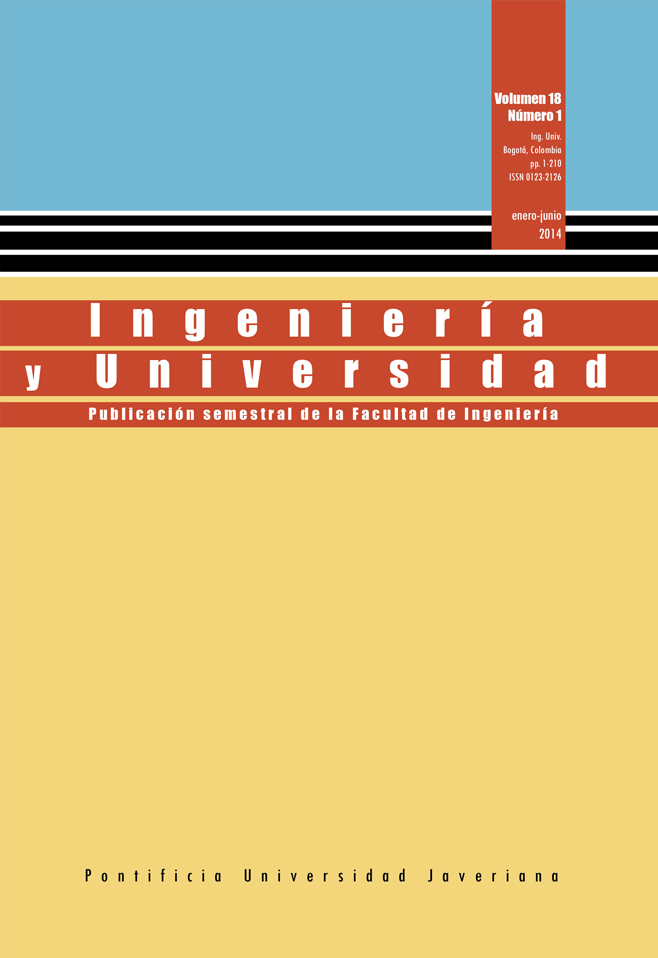Abstract
This paper presents a mathematical model to obtaina failure indicator of stator faults based on the negativesequence component of the electric current. The modelcan be used in online diagnosis systems to separate theeffects of voltage unbalance factor and the constructiveasymmetries of the machine. Results of the application ofthe model were validated trough laboratory tests madeinto a specially modified motor and results were applied tosuccess diagnosis of two motors of higher electrical power.As a main result of the work, a low computationalmodel was obtained to diagnose a quick evolution failurethat can evolve quickly to a thermal collapse of the statorwinding with consequent repair costs.
BOUZID, M. y CHAMPENOIS, G. Accurate stator fault detection insensitive to the unbalanced voltaje in induction motor. Marseille: The Institute of Electric and Electronics Engineers, 2012.
DÍAZ, D.; DÍAZ, R.; AMAYA, M. C. y PALACIOS, J. Análisis del cortocircuito entre espiras de un motor de inducción tipo jaula de ardilla mediante la aplicación del método de elementos finitos (mef). Revista de la Facultad de IngenierÍa Universidad de Antioquia. 2010, vol. 51.
IEEE INSTRUMENTATION AND MEASUREMENT SOCIETY. IEEE guide for diagnostic field testing of electric power apparatus - electrical machinery. New York: The Institute of Electrical and Electronics Engineers, 2004.
IEEE POWER & ENERGY SOCIETY. IEEE STD 1159-2009 Recommended practice for monitoring electric power quality. New York: The Institute of Electrical and Electronics Engineers, 2009.
IEEE POWER ENGINEERING SOCIETY. IEEE STD 112TM-Standard test procedure for polyphase induction motors and generators. New York: The Institute of Electrical and Electronics Engineers, 2004.
NANDI, S.; TOLIYAT, H. y XIAODONG, L. Condition monitoring and fault diagnosis of electrical motors—a review. New York: IEEE Transactions on Energy Conversion, 2005.
PAZ PARRA, A et al. Consideraciones acerca del uso de la corriente de secuencia negativa como herramienta de diagnóstico de fallas estatóricas en motores de inducción de jaula de ardilla. 16 Convención Científica de Ingeniería y Arquitectura, La Habana, Cuba, 2012.
SOCIETY, ELECTRIC MACHINERY COMMITTEE OF THE IEEE POWER ENGINEERING. IEEE STD 43TM-recommended practice for testing insulation resistance of rotating machinery. New York: IEEE-SA Standards Board, 2000.
VERUCHI, C. J. y ACOSTA, G. G. Técnicas de detección y diagnostico de fallos en máquinas eléctricas de inducción. IEEE Latin America Transactions. 2007, vol. 5, pp. 41-49.
VILLADA DUQUE, F.; CADAVID, D. y VELILLA, E. Modelamiento del motor de inducción para estudios de cortocircuito entre espiras del estator. Revista Facultad de Ingeniería Universidad de Antioquia. 2010, vol. 51, pp. 7-15.
This journal is registered under a Creative Commons Attribution 4.0 International Public License. Thus, this work may be reproduced, distributed, and publicly shared in digital format, as long as the names of the authors and Pontificia Universidad Javeriana are acknowledged. Others are allowed to quote, adapt, transform, auto-archive, republish, and create based on this material, for any purpose (even commercial ones), provided the authorship is duly acknowledged, a link to the original work is provided, and it is specified if changes have been made. Pontificia Universidad Javeriana does not hold the rights of published works and the authors are solely responsible for the contents of their works; they keep the moral, intellectual, privacy, and publicity rights.
Approving the intervention of the work (review, copy-editing, translation, layout) and the following outreach, are granted through an use license and not through an assignment of rights. This means the journal and Pontificia Universidad Javeriana cannot be held responsible for any ethical malpractice by the authors. As a consequence of the protection granted by the use license, the journal is not required to publish recantations or modify information already published, unless the errata stems from the editorial management process. Publishing contents in this journal does not generate royalties for contributors.


